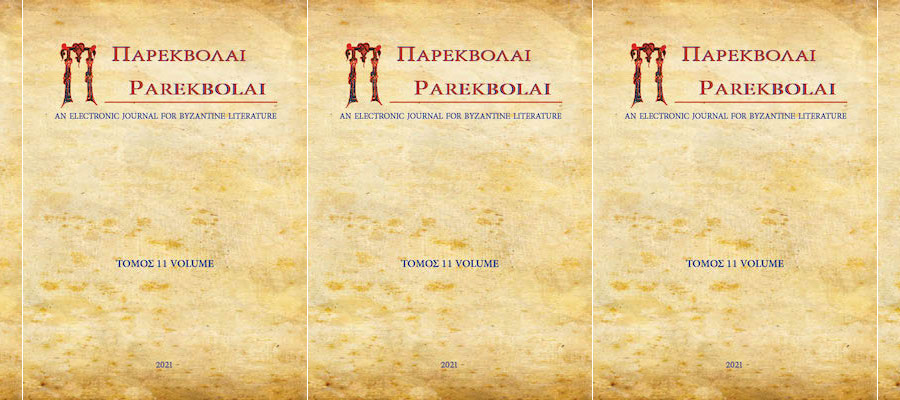Parekbolai. An Electronic Journal for Byzantine Literature, volume 11 (2021).
CONTENTS
Διορθωτικά στον Δίδυμο τον Τυφλό
Ioannis Polemis
The new edition of Didymus the Blind’s Commentary on Psalms 26: 10 – 29: 2 and 36: 1-3 (P.BYU I) offered us the opportunity to propose some emendations to the text.
Smell of Sweat, Smell of Semen: The Divinisation of Body Fluids in Patriarch Methodius' Life of Theophanes of Agros
Dirk Krausmüller
This article makes the case that Patriarch Methodius’ Life of Theophanes is not a straightforward hagiographical narrative but a vehicle for theological and anthropological speculation. Focusing on the description of a miracle – the appearance of divine sweet smell in the room where Theophanes and his wife perform ascetic activities – it argues that the sweat of the couple become the locus for a divine manifestation, and that it is at the same time a placeholder for semen through which the marriage of the two saints is consummated.
Nicetae Heracleensis Commentarii in Gregorii Nazianzeni orationes fr. 125 Constantinescu
Emanuele Dettori
Reading between the lines of a Byzantine ‘paraphrase’: (re)discovering Isaac Komnenos and the Letter of Aristeas
Valeria Flavia Lovato
In a recent study on the illuminated Octateuchs, Lowden has defined this group of luxurious manuscripts as a typically ‘Byzantine phenomenon’. The present paper focuses on Isaac Komnenos’ paraphrase of the Letter of Aristeas, a unique feature of the Seraglio Octateuch.
The few modern scholars who have dealt with it have been rather ungenerous in their assessments of Isaac’s literary enterprise. Through an analysis of the structure of the paraphrase and a systematic comparison with the Letter of Aristeas, I demonstrate that these appraisals do not do justice to Isaac’s work, in that they fail to see both the reasons for his interest in this text and the rationale inspiring his rewriting. As I argue, far from being the fruit of Isaac’s abstruse ‘phantasies’, the paraphrase opening the Seraglio Octateuch was carefully structured to fit his self-fashioning agenda, which, in turn, was deeply influenced by the sociopolitical and cultural climate of 12th-century Byzantium. In short, the Seraglio Octateuch will prove to be not just a ‘Byzantine phenomenon’ but a typically Komnenian one.
Μυθολογικές μορφές και μυθολογικά παραθέματα στο ιστορικό έργο του Δούκα
Maria Varela
Douka’s Historia Turcobyzantina is a purely historical text imbued with rhetorical elements. One of these is the exemplary function of mythological quotations and figures. These citations can be classified as follows: the mythological character of Fortune and its variations; heroes’ bravery; mythological events or scenes; mythological figures; mythological creatures and mythological objects. The author’s choices are astute and famous (heroes and gods, e.g. Achilles, Hercules and Aphrodite; well-known scenes, e.g. Peleus’ and Thetis’ wedding). The variety of quotations is a literary and rhetorical element and their unexpected appearance surprises and satisfies the reader. He is called upon to find out the relation between the historical person or fact and its mythological parallel.
Some Remarks on the Structure of John Eugenikos' Ekphraseis of Cities and Places
Ilias Chrysostomidis, Dimitrios Nikou, and Ilias Taxidis
This article attempts a global survey of the similarities observed in the ekphraseisof cities and places composed by John Eugenikos, on the one hand identifying the structural similarity they display and on the other tracing the form they appear to follow. The ultimate object is to highlight the differences between them, which are not simply a matter of divergence from the common framework but on the contrary demonstrate the writer’s striving for originality in these texts.
